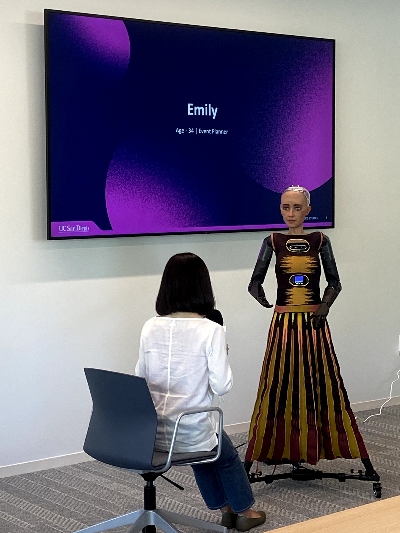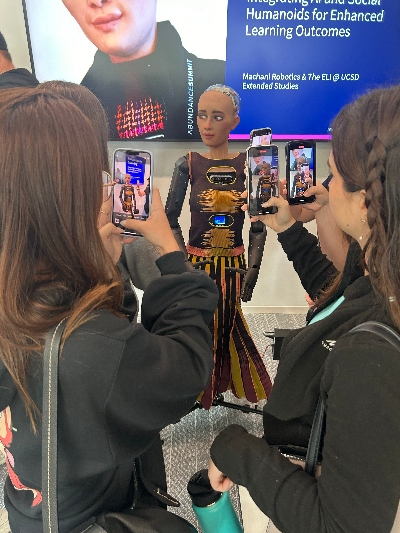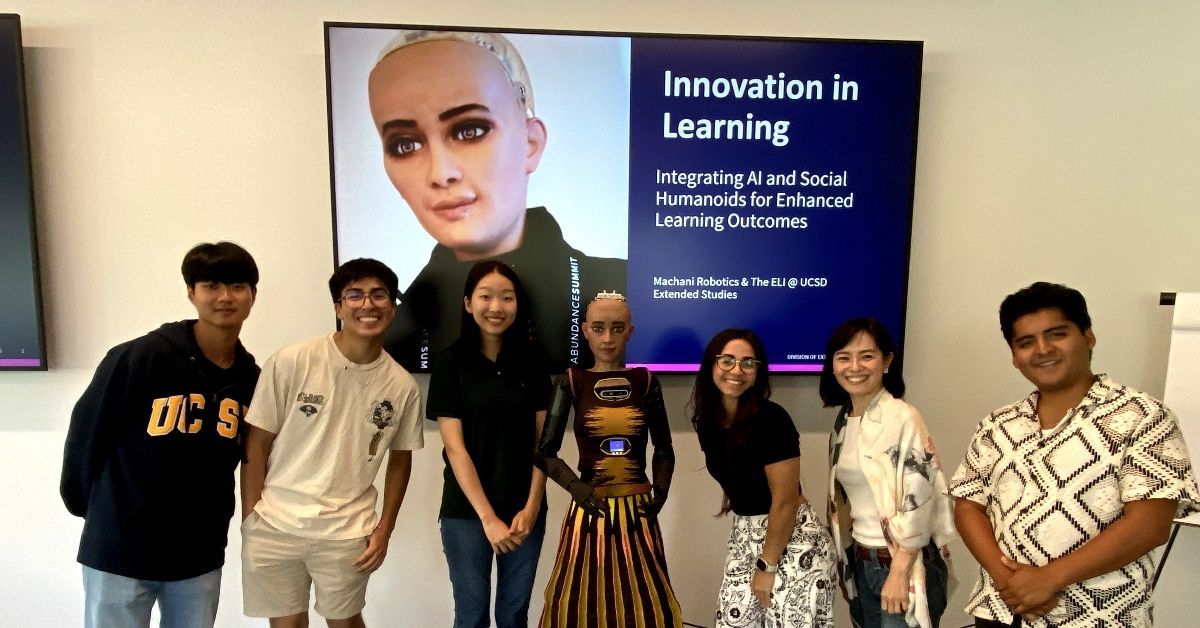Integrating AI into Language Learning: UC San Diego Extended Studies Offers First Class Experience with RIA Robot
UC San Diego’s Partnership with Machani Robotics Sparks Innovation at the English Language Institute
Media contact:
Published Date
Article Content
It started with an offhand comment from a colleague about a talking robot.
“That's not something you hear every day, so my ears perked up,” recalled Jonathan Rezach, Program Manager for the English Language Institute (ELI), within International Programs at UC San Diego Division of Extended Studies.
His colleague, Jane Starrett, Special Projects Coordinator for Extended Studies International Programs, was heading to a demonstration of "Robotics Interactive Assistant," or RIA, an artificial intelligence (AI) powered humanoid robot developed by Machani Robotics. Rezach was invited to see RIA for himself.
"I immediately thought about how we could bring this into the classroom, particularly for our medical English students," said Rezach.
Always looking to improve the student experience, Rezach wondered if a tool like RIA could be leveraged to help English as a Second Language (ESL) students learn better conversational English. He thought the opportunity might be especially valuable for simulating doctor-patient roleplays for international medical English students.
This spark of curiosity quickly evolved into a valuable collaboration between Machani Robotics and the English Language Institute's (ELI) Medical English program.
Bringing AI into the classroom

The ELI Medical English program runs several times a year and is designed to help international healthcare professionals and students—practicing and in-training doctors, nurses, and medical administrators—improve their command of English medical terminology and contextual language.
Students from all over the world travel to San Diego to take the immersive four-week course, offered by UC San Diego Extended Studies. For many of the international students in the program, mastering English is not just a professional necessity; it's a gateway to greater opportunities.
“Many international health care providers are already proficient in academic and conversational English. They are looking to take their English skills to the next level. Promotions, jobs, and higher earnings are just a start,” said Patti Juza, Associate Dean of Extended Studies and Executive Director of International Programs. “Many of our students need English to be able to communicate effectively with their international patient populations. Quality care and communication are prioritized.”
Like in many ESL programs, case studies and scenarios play a big role in the curriculum. When Rezach heard about RIA, he immediately recognized the potential to elevate these role-plays to a new level, providing students the opportunity to practice their English in a more realistic and engaging way. UC San Diego Extended Studies leadership agreed.
"This is a chance for us to use the most cutting-edge research, cognitive science and robotics to help working professionals improve their English language skills, beyond grammar, word choice, and pronunciation," Juza.
Machani Robotics was excited about the potential collaboration too.
"This collaboration was a unique opportunity for us to see RIA as a learning companion in the classroom," said Shubha Koneru, Senior Vice President of Product Strategy and Partnership at Machani Robotics. "We were excited to explore the meaningful ways in which RIA could enhance the learning experience for students."
Understanding RIA: more than just a robot
The ELI team learned that RIA was not just any robot.
Described as an "advanced pilot-ready prototype of a social humanoid," RIA was designed to engage with humans on a deeply empathetic and emotionally intelligent level.
"RIA can speak compassionately—almost like a human," said Koneru. "RIA can pick up on emotional cues, reflect them in conversations, and even express them through facial expressions and gestures."
From the point of view of the ELI, the unique value of using an AI-powered conversational humanoid is that RIA can flawlessly play out a variety of patient scenarios, complete with presenting symptoms, lifestyle, personal concerns, and medical histories, all drawn from "large language models" (LLMs) of AI intelligence. RIA is also alert, imaginative, and equipped with complex background knowledge on a consistent and ad-hoc basis.
This role-play would allow ELI students to engage in highly realistic doctor-patient interactions, in which RIA consistently takes the stance of the patient.
“RIA doesn't get tired, she doesn't check her smartphone, and she doesn't have bad days," Rezach noted. "The consistency she brings to the roleplay is unmatched."
Koneru emphasized RIA's "infinite patience and creative role-play capabilities" as especially valuable in education.
"Unlike humans, who might eventually become bored, frustrated, or lose focus, RIA remains endlessly patient and fully engaged. Her ability to creatively assume different roles and characters brings a new dimension to personalized learning, where consistent practice and individualized attention are key to student success.
This is a chance for us to use the most cutting-edge research, cognitive science and robotics to help working professionals improve their English language skills, beyond grammar, word choice, and pronunciation.
The impact on student learning
When RIA made her debut in the classroom, the impact was immediate. The ELI students were captivated by the humanoid, not just because of her lifelike appearance, but because she offered them an entirely new way to practice and improve their English.
"I was expecting more of a science-fiction movie robot, like C-3PO from Star Wars," said Dr. Ana Caroline Jerke, a medical doctor from Brazil who participated in the ELI Medical English program. "The fact that I want to say 'her’ instead of 'it’ might express to you how realistic it actually is. You realize that it is still a machine, but an incredibly developed machine that does more and better than any other machine I had ever seen before."
RIA inspired the students to take the role plays seriously. They prepared ahead of time and admitted to feeling nervous, much like they would in a real medical setting.
Students also had to push themselves to maintain fluid, uninterrupted speech with RIA.
Much like a human, RIA would interpret any long pauses as an indication to respond. This challenged the students to improve their fluency, which is one of the most difficult aspects of learning a second language, especially in a medical context.
"The students were so captivated by RIA that they voluntarily stayed after class, which is unheard of," Rezach noted. "Not a single person was on their smartphone either. It shows that RIA brought something special to the table—something that resonated deeply with the students."
The interactions were a learning experience for RIA, too.
"RIA isn't meant to just be a teacher's aide in the classroom—she learns and adapts with every interaction," Koneru explained. "Each role play and conversation enhances her social capabilities and makes her an increasingly valuable resource in healthcare and education."
Future versions of RIA will be able to provide personalized feedback to students, highlight areas for improvement, and offer focused learning recommendations toward skills that will most impactfully enhance the student's progress in the class.
As AI continues to evolve, both Jerke and Rezach see nearly infinite possibilities for its application in education.
"From this starting point, I could imagine a long list of utilities for RIA in the medical field," said Dr. Jerke. "RIA could teach the elderly how to navigate modern technology or help with scheduling and sharing information in doctor's offices."
Dr. Jerke sees a more empathy-driven opportunity, too.
"Having a socially intelligent AI to help train doctors on their communication skills, especially for difficult conversations, would be an incredible alternative to the ‘try-it-and-see-what-happens' approach most doctors use," Dr. Jerke added. "It definitely would have been beneficial to me when I was learning how to communicate bad news or interact with patients, in general. It takes off the pressure of hurting the other person or not correctly conveying what you want to say."
Rezach is especially optimistic about the opportunities.
"AI can do so much more than we ever imagined,” he said. “It's not just about making tasks easier or faster; it's about creating new opportunities for learning and growth that weren't possible before. That's where we see the future of AI in education—providing tailored learning experiences that help each student progress at their own pace.
The role of the UC San Diego Office of Innovation: bridging technology and education
While Rezach's enthusiasm and initiative were key to bringing RIA into the classroom at the Division of Extended Studies, the collaboration between Machani Robotics and the ELI would not have been possible without the support of UC San Diego's Office of Innovation.
This office, which bridges the gap between emerging technologies and practical applications within the university, was instrumental in connecting Rezach with Machani Robotics.
"We're the front door to the campus for innovation," said Greg Horowitt, Director of Innovation Design at UC San Diego. He added that the Office of Innovation often operates as a type of 'concierge,' connecting innovative people, technologies, and companies with campus resources and communities that can potentially offer each other the most impact.
"We're curators and caretakers of innovation," said Paul Roben, Associate Vice Chancellor for Innovation at UC San Diego. "We're always trying to predict where the future is going and what skills and technologies will be needed to get there. That's why we engage with key players in various industries—whether it's AI in healthcare, the space economy, or climate adaptation—because these are the areas where our students and faculty can make the most impact."
One of the most important aspects of the curating and connecting that happens at the Office of Innovation is the involvement of students in the development and testing of new technologies.
"Students are one of the best places to explore how new technologies might be used," said Horowitt. "The way they interact with technology often provides insights and ideas that we wouldn't get from other sources."
"This not only benefits the students but also the broader community as they help develop new solutions," added Roben.
This approach was crucial in the collaboration with Machani Robotics. By involving students in testing and interacting with RIA, UC San Diego not only enhances the learning experience for those in the ELI Medical English program but also gathers valuable data on how such technologies can be applied in real-world scenarios.
Collaborations such as this one with the Division of Extended Studies are a prime example of how the UC San Diego Office of Innovation can harness the power of emerging technologies to enhance education and solve real-world problems.
"We create conditions where new ideas can be explored, tested, and developed, increasing the chances that something worthwhile will emerge," said Roben. "It's not about predicting the future—it's about creating the nest where the future can be born.
We're curators and caretakers of innovation. We're always trying to predict where the future is going and what skills and technologies will be needed to get there. That's why we engage with key players in various industries—whether it's AI in healthcare, the space economy, or climate adaptation—because these are the areas where our students and faculty can make the most impact.
A partnership built on openness
Machani Robotics' openness and willingness to collaborate were key to creating an effective partnership between UC San Diego and the technology company.
"Machani was very willing to work with our students and make RIA available," Roben noted. "A lot of companies are very protective of their technologies, but Machani recognized the win-win situation here. They're not just focused on making money but on how they can make the world a better place."
"We were genuinely excited about the opportunity to partner with UC San Diego," said Koneru.
"This collaboration allowed us to experience the humanoid's intended use in action," Koneru continued. "Watching the students interact with RIA and seeing the benefits gained in the pilots was incredibly rewarding. It reaffirmed our vision to transform and enhance how learning and care will be delivered in the future."
This collaboration allowed us to experience the humanoid's intended use in action. Watching the students interact with RIA and seeing the benefits gained in the pilots was incredibly rewarding. It reaffirmed our vision to transform and enhance how learning and care will be delivered in the future.
The future of AI technology at UC San Diego
Looking ahead, the Office of Innovation sees RIA as part of a broader trend of technological development, where multiple technologies intersect to create something new.
"The future is going to be in the convergence of technologies," Horowitt said. "It's not going to be just an engineering solution or a business solution; it's going to be where all these things intersect."
As might be expected based on the hype, AI is currently at the center of many of these convergences.
"AI is touching everything these days," Roben said. "Most of the solutions and ideas coming through our office have some AI angle or application. Whether it's healthcare, urban planning, or even education, AI is becoming an integral part of how we approach problem-solving."
Koneru and the team at Machani Robotics also imagine embodied AI will be a fixture in our future lives.
"We see RIA as part of a broader movement towards integrating AI into everyday life," Koneru remarked. "The pilot in education is just the beginning. The potential applications in healthcare, elder care, and supporting those with Intellectual and Developmental Disorders (IDD) are vast. We are eager to explore these avenues with forward-looking partners like UC San Diego."
A new era in education

The collaboration between UC San Diego and Machani Robotics is more than just a technological experiment—it's a glimpse into the future of education.
As the world continues to evolve, so too must the methods we use to educate and prepare the next generation of professionals.
By integrating RIA into the ELI Medical English program within the Division of Extended Studies, UC San Diego is enhancing the learning experience for its global student body and setting a new standard for using AI in language education.
"Many of our health care providers are trying to learn Spanish, Tagalog, or Vietnamese to be able to work with members of the community in their own languages," said Associate Dean Juza.
RIA, who has been tested to speak in 16 different languages and can convey 100 distinct facial expressions, will be instrumental in equipping professionals to serve a diverse and global audience.
"We want to differentiate ourselves from the competition and be a trendsetter in education," concluded Rezach. "By embracing AI, we're offering our students opportunities that don't exist anywhere else. This is just the beginning, and I'm excited to see where it takes us."
With AI-powered tools like RIA leading the way, the future of education looks brighter—and more innovative—than ever before.
Learn more about research and education at UC San Diego in: Artificial Intelligence
Share This:
You May Also Like
$10 Million Grant from Price Philanthropies Launches Behavioral Health Hub at UC San Diego Health
Health & BehaviorStay in the Know
Keep up with all the latest from UC San Diego. Subscribe to the newsletter today.




